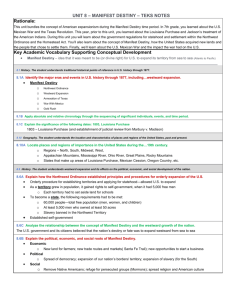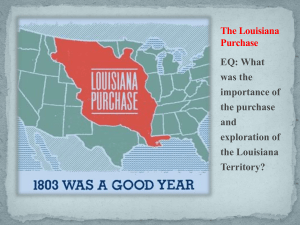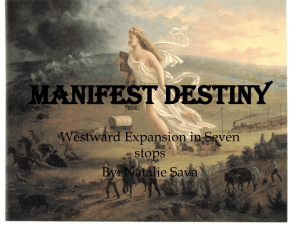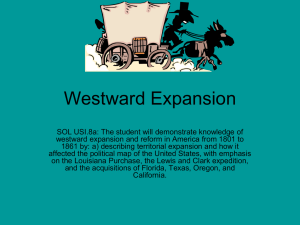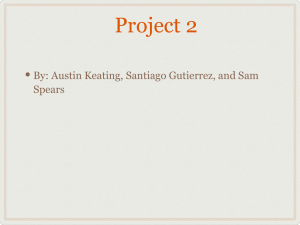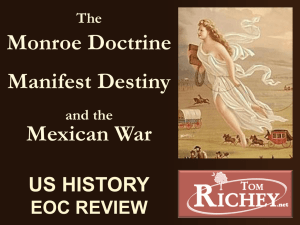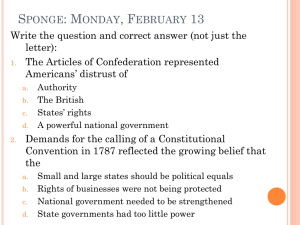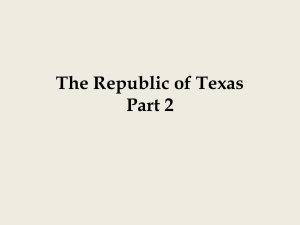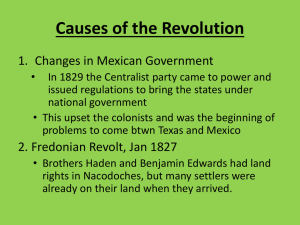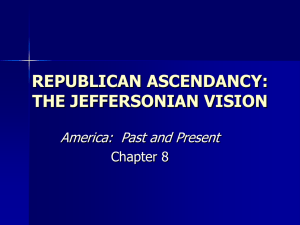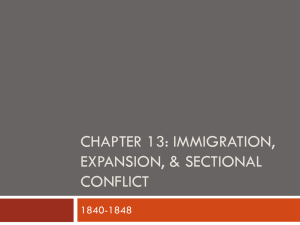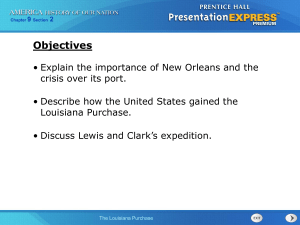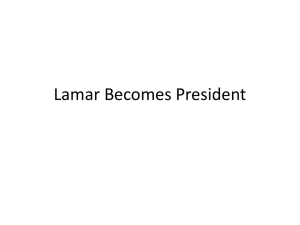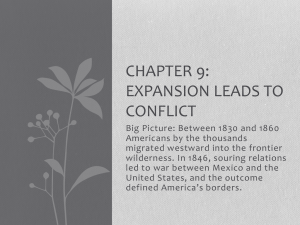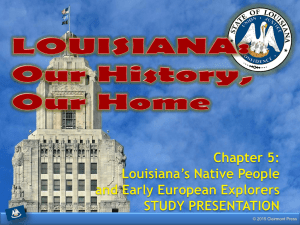Document
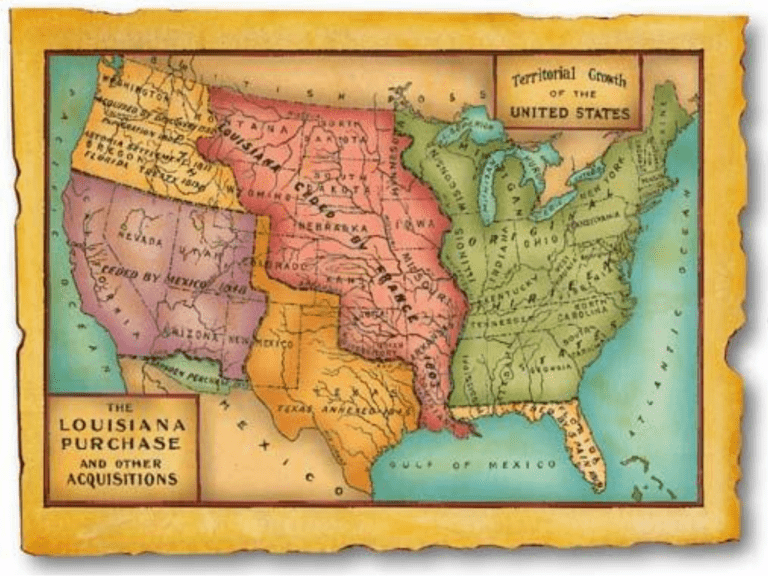
Introduction
Throughout the first half of the
1800s or 19th century there were many factors influencing United
States expansion. From the Louisiana
Purchase in 1803 to other land acquisitions, by 1853 the United
States had tripled in size since its original thirteen colonies.
The idea of Manifest Destiny spread quickly throughout the country and soon thousands were moving westward in search of a new way of life. The idea of Manifest Destiny was for the U.S. to occupy the entire continent. The only problem was that the land it was expanding on to didn’t belong to the U.S.
Manifest Destiny affected the economic and social development of the U.S. because certain areas or regions would produce specific products. The greatest factor affecting the migration across the land was geography. Mountains, rivers, lakes, plains, and in some cases canyons were among the biggest impediments for people moving out west.
Review
Thomas Jefferson had been elected the 3 rd President of the United States.
The Jeffersonian Era had been considered a type of political revolution, in that a new way of thought emerged.
A change from the centrist viewpoint of the central government to more of a popular approach towards more local control.
Conflict with England and France had eased and the economy in the
United States was growing.
Jefferson had taken a different fiscal approach towards reducing taxes and government debt. He put more money into the common persons pockets and spending increased.
There was also this sense of Nationalism emerging regarding a sense of pride in being an American and all the possibilities that came with this privilege.
The country began to grow in population, financially and miles.
Manifest
Destiny
Manifest Destiny was a belief that the
United States had a divinely-inspired mission to expand across the North American frontier towards the
Pacific Ocean.
The phrase, which means “the undeniable fate”, was coined by
New York journalist when he wrote that "it was the nation's manifest destiny to overspread and to possess the whole of the continent which Providence has given us for the development of the great experiment of liberty and federated self-government entrusted to us."
Manifest Destiny was never a specific policy or ideology; it was a general notion that combined elements of American exceptionalism, nationalism, expansionism, and racism.
Some people still believe that aspects of Manifest Destiny form an underlying part of American attitude and foreign policy.
Manifest Destiny
Westward Expansion
As the citizens of the U.S. spread westward, intense conflict with both the Native Americans and Mexico were inevitable.
Already heavily depopulated due to diseases, the Native American peoples were unable to resist the endless stream of white settlers and the military that accompanied them.
Conflict with Mexico was more formal but also resulted in the large scale acquisition of land for U.S. settlers.
President Polk made it clear in his diaries that he had every intention to seize any Mexican territory that fell into U.S. hands.
Manifest Destiny was basically the imposition of majority rule on minorities which proved to be horrific.
The Manifest
Destiny Mindset
Since the time when the first European set foot on the North
American continent, the roots of Manifest Destiny were planted.
The desire to acquire fresh land to the West was always a predominant mindset in the colonists an eventually the United
States citizens.
The attitude of the US citizens, new European immigrants (all of which were predominantly white people) was that for some reason this land was free for the taking!
The politics of the day and the people who made up the United
States government believed they had this preordained right from
God that this land was theirs – Coast to Coast!
The slogan was, “Move West Young Man” and they did.
The European Attitude
An early example of this attitude was what happened with the Louisiana.
As you might recall, Napoleon (France) has this grand scheme to create this World Wide Empire similar to what Alexander the Great had established.
His vision for the North American continent was to use the farm land to grow food for his troops and to utilize the natural resources the land could provide for his armies.
The point must be made, that Napoleon represented a very
European imperialistic attitude that was inherent in the European mindset.
Europeans believed that with power and force, whatever they could take was rightfully theirs.
Thus France had staked their claim for the Louisiana Territory and as well controlled the Port of New Orleans.
The Louisiana
Purchase
However, as it turns out, Napoleon could not afford to conquered
Europe and maintain control over his North American assets. He runs into a cash flow problem.
It was also at this time that Jefferson and his colleagues became worried about the French presence West of the Mississippi River and their ultimate control of the Port of New Orleans.
Jefferson proposed that the United State buy the rights of New
Orleans from France to control the economic trade flow out of the
Port. They could not afford to have France controlling their commerce up and down the Mississippi River.
So it was that Jefferson sent James Madison to Paris to propose the
New Orleans purchase for 7.5 million dollars
Napoleon, the opportunist realized that he could resolve his two of his most pressing dilemmas, cash flow and control of Louisiana.
The Louisiana
Purchase
Napoleon countered Madison's offer and proposed the sale of the entire Louisiana Territory for 15 million dollars.
This put Jefferson in a philosophical quandary over his past
Constitutional stance when he was bickering with Hamilton.
In the end, Jefferson and Congress realized this was an opportunity they could not pass up.
With the purchase of the Louisiana Territory, the physical sized of the United States more than doubled.
This brought up some other issues:
What right did they have to buy this land?
How were they going to govern and protect this land?
And perhaps most important, what and who were on this land?
The Louisiana
Purchase
The Louisiana Purchase was the largest and most extraordinary land purchase in the history of the United States. It was also the cheapest (per square mile).
At the turn of the 19th Century, Americans were moving further westward. Settlers had crossed the Appalachian Mountains and headed for parts known and unknown.
Pioneers like Daniel Boone had blazed trails and roads, allowing families to travel to new places. Soon, the Northwest Territory and other places were bustling with Americans.
Everyone wanted more: more places to live, more livestock for their farms.
The one thing that the United States Government wanted more of was land. And the Louisiana Territory had a lot of land.
Lewis and Clark
An event of the magnitude of the Louisiana
Purchase affected everything to come after.
The government would have to assume new responsibilities.
The nation's destiny was firmly oriented westward and guaranteed that the economy would remain primarily agricultural for decades to come and would characterize American society and government.
The United States acquired much greater security on its own borders as well as greater power and self-assurance in international affairs.
With the purchase of the Louisiana Territory, Jefferson wanted to send an expedition across the continent.
Captain Meriwether Lewis, whom he had chosen to lead this expedition, set forth from Washington on 5 July 1803.
Presenting it to Congress Jefferson emphasized its commercial purpose: to chart a continuous line of navigation along the Missouri River route to the
Pacific. The Lewis and Clark Expedition was originally called The Corp of Discovery
Lewis and Clark Expedition
The vast areas of unexplored country offered the new nation the potential for growth and the possibility of a practical water route all the way to the Pacific
Jefferson had for years been fascinated by the unexplored territory west of the
Mississippi River, and in June 1803 he announced plans to send an expedition overland to the Pacific.
The President chose his close friend Meriwether Lewis to lead the expedition. Lewis selected his friend and former commanding officer,
William Clark, to serve as co-leader of the expedition. The objective was to explore the Missouri River to its source and establish the most direct water route to the Pacific.
They were instructed to write detailed accounts of their journeys, make maps, and provide information about the Indian Tribes indigenous to the west.
In addition Jefferson expected them to make scientific and geographic observations of all they saw. In 1804, Lewis & Clark, along with 45 men and a dog, began a journey that would take three years and cover territory that would later encompass 11 states.
Lewis and Clark Expedition
The Lewis and Clark Expedition of 1803-06 was a monumental event that shaped the boundaries, character and future of the
United States.
The courageous explorers traveled up the Missouri River, across the
Great Plains, over the Rocky
Mountains, down the Columbia
River to the shores of the Pacific and back again.
Although a great deal has changed during the past 200 years, many of the sweeping landscapes and powerful waters so eloquently described by the
Corps of Discovery have been permanently protected for future generations.
The National Park Service today has the honor of preserving and managing numerous areas and programs that acknowledge or are related to the Lewis and Clark Expedition.
The Corps of Discovery is commemorated in many areas throughout the western part of the United States.
Westward Expansion
Another huge factor that played a role in the westward expansion was that of available resources.
As the people began to move westward they would settle in areas with vast amounts of natural resources such as lakes or streams, where they could gather food.
Lakes were very important to travel because they provided drinking water for the people and attracted wild animals to the area, which could be hunted for food.
Also if an area were to dry or rocky it wouldn’t be settled. People looked for the best places to live, places they could profit from the most.
During the gold rush everyone traveled to the western coast in hopes of becoming rich for the very same reason.
The Mexican Wars
The war between Mexico and the United States had its beginnings with the struggle over who would control Texas.
American settlers began moving to the Texas territory in the 19th Century, after the
Revolutionary War had been won and the exploration of lands west of the Appalachian
Mountains had begun.
The Louisiana Purchase had stretched the western boundaries of the United
States farther west than they had ever been.
After the success of Lewis and Clark, more and more Americans explored and settled in the Louisiana Territory.
And right next to Louisiana was Texas. Texas was big land, rich with resources and possibilities. It was also largely part of Mexico.
As more and more Americans moved to the Texas territory, the cry grew for
Texas to be part of the U.S. This began to happen in 1835, when Texas declared itself independent from Mexico. The Texas Republic was born, and its first president was Sam Houston. The secretary of state of this new republic was Stephen F. Austin, who had been a pioneer in helping settle the
Texas territory .
The Mexican Wars
The war between America and Mexico officially began on April 25, 1846 when the opposing forces clashed on the southern border of Texas.
Its origin was much earlier when Texas declared independence from Mexico in 1835. The Mexican response included the Battle of the Alamo in 1836.
This violent response resulted in the death of hundreds of Americans, including James Bowie and David Crockett.
In 1844, United States president James K. Polk annexed Texas as a U.S. territory, which further encouraged hostilities.
The Mexican War was the first fought by American forces on foreign soil.
The landing near the city of Vera Cruz on March 12, 1847 was the first ever amphibious landing made by American troops. The Americans eventually won the war and for some time occupied Mexico. That was the first time
American forces had ever occupied another nation.
The US occupation of Mexico City on September 14, 1847 ended the fighting. The war officially ended on February 2, 1848 with the signing of the Treaty of Guadalupe Hidalgo. The treaty recognized American annexation of Texas, and turned more than half of Mexico's territory over to the U.S. for a $15 million payment from the U.S. to Mexico. The ceded territory included the states of California, Utah and Nevada and parts of
Colorado, Arizona and Wyoming.
Manifest Destiny and Imperialism
The United States experienced its most rapid territorial growth during the mid-1840s.
The US annexed Texas in 1845, acquired Oregon from
Great Britain in 1846, and conquered California and
New Mexico during the U.S.-Mexican War.
The nation also obtained vast cessions from Native
American tribes, which were relocated to remote and unwanted regions, a process begun in the seventeenth century.
Imperialism is basically the extension by a country of its power into and over other countries with an intention of either ruling them directly as part of one's own country's empire or indirectly in the sense of ensuring that they are governed by natives friendly to one's own country.
"Manifest destiny" is simply the propaganda language used by proponents of the expansion of the United States into what they perceived as its natural land, which took place mostly during the 19th century.
Although the differences might appear major. The end result is still conquest. The US so-called "manifest destiny" involved conquering territory militarily and taking over the rule of the native peoples, and of parts of Mexico and Russia, and of lands previously belonging to Spain and
France.
